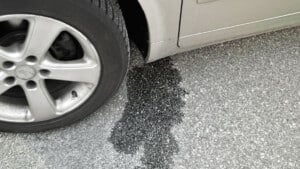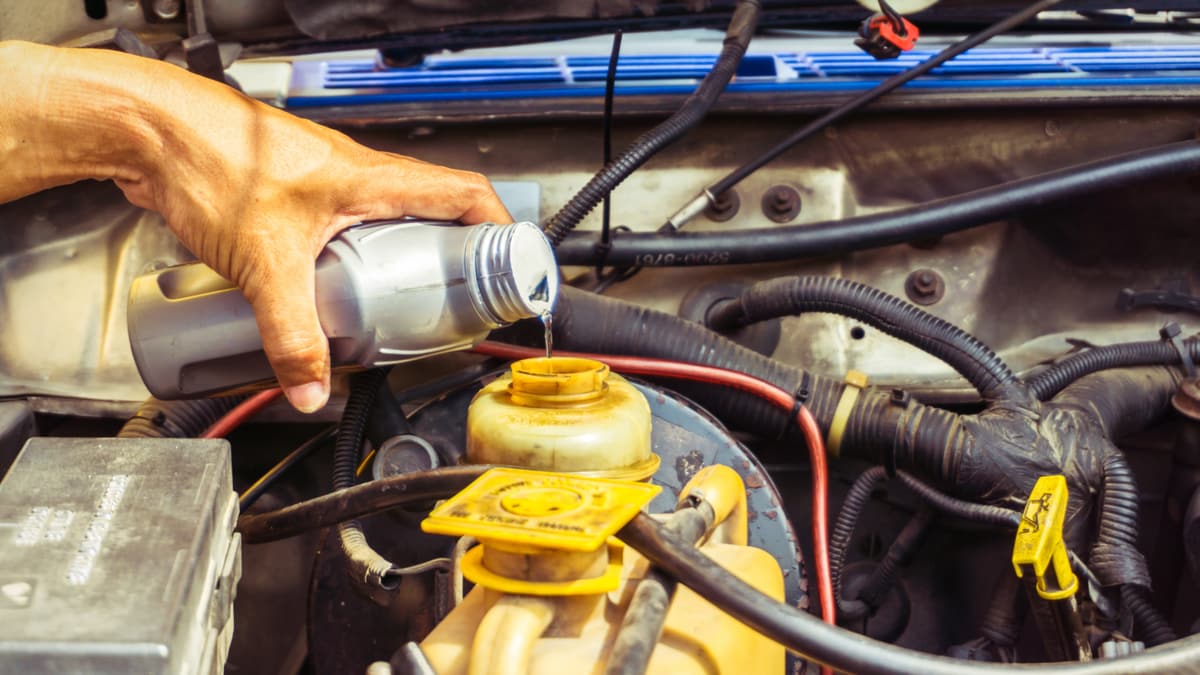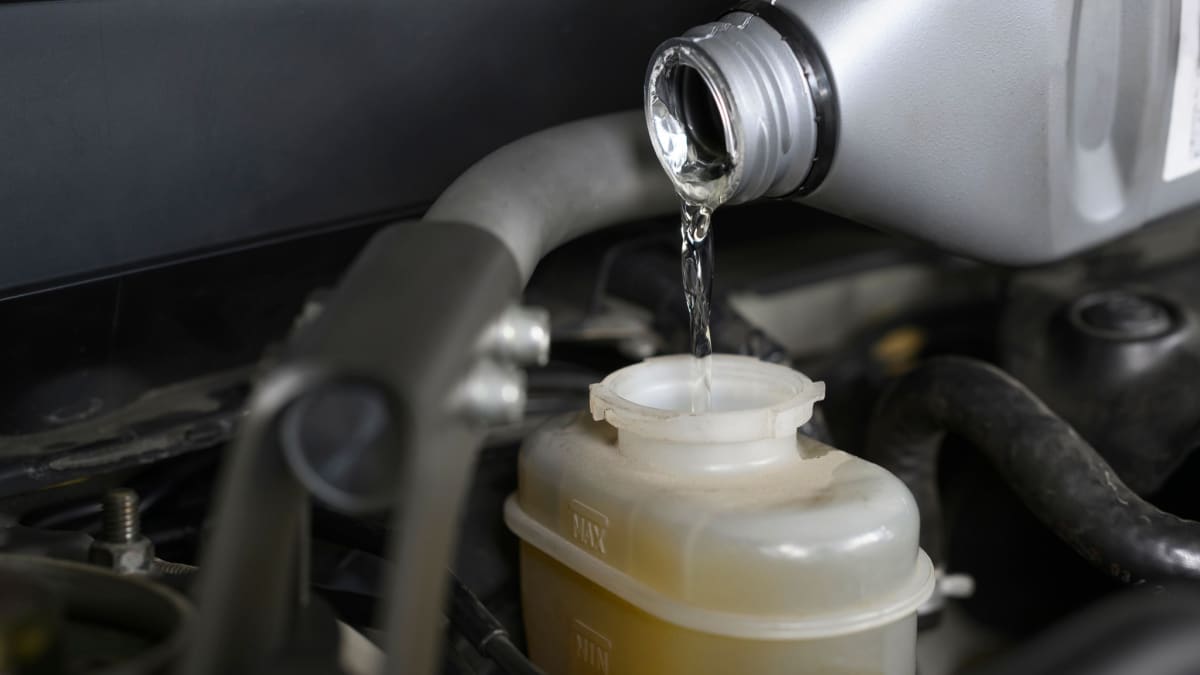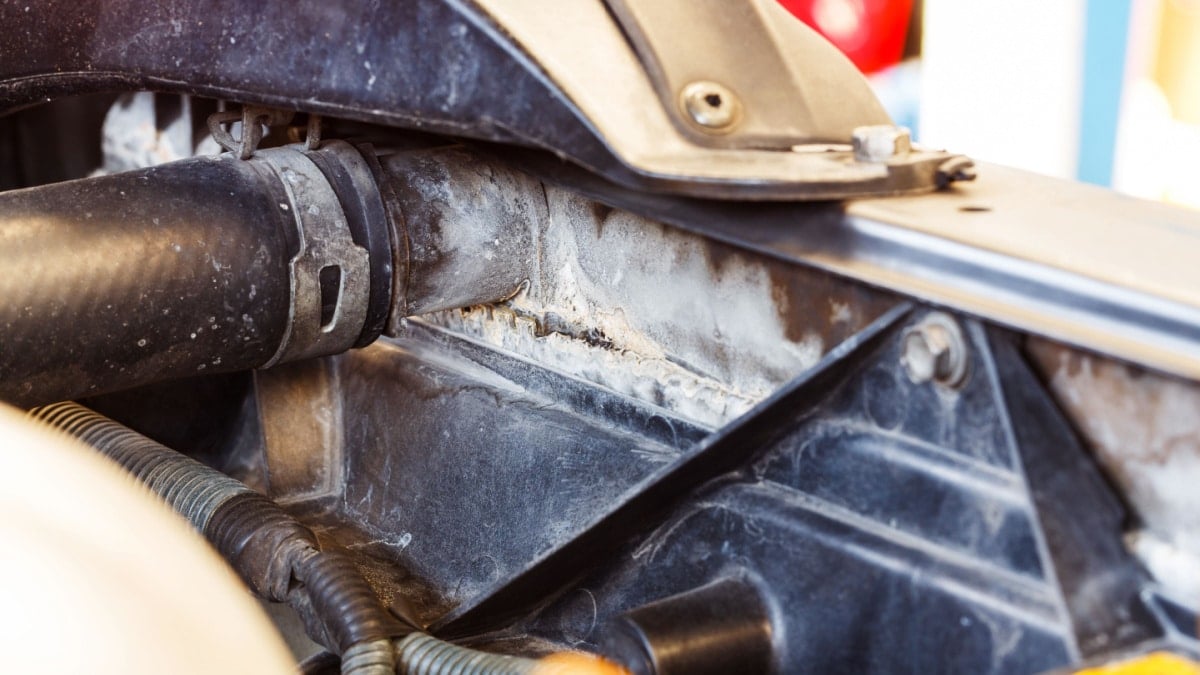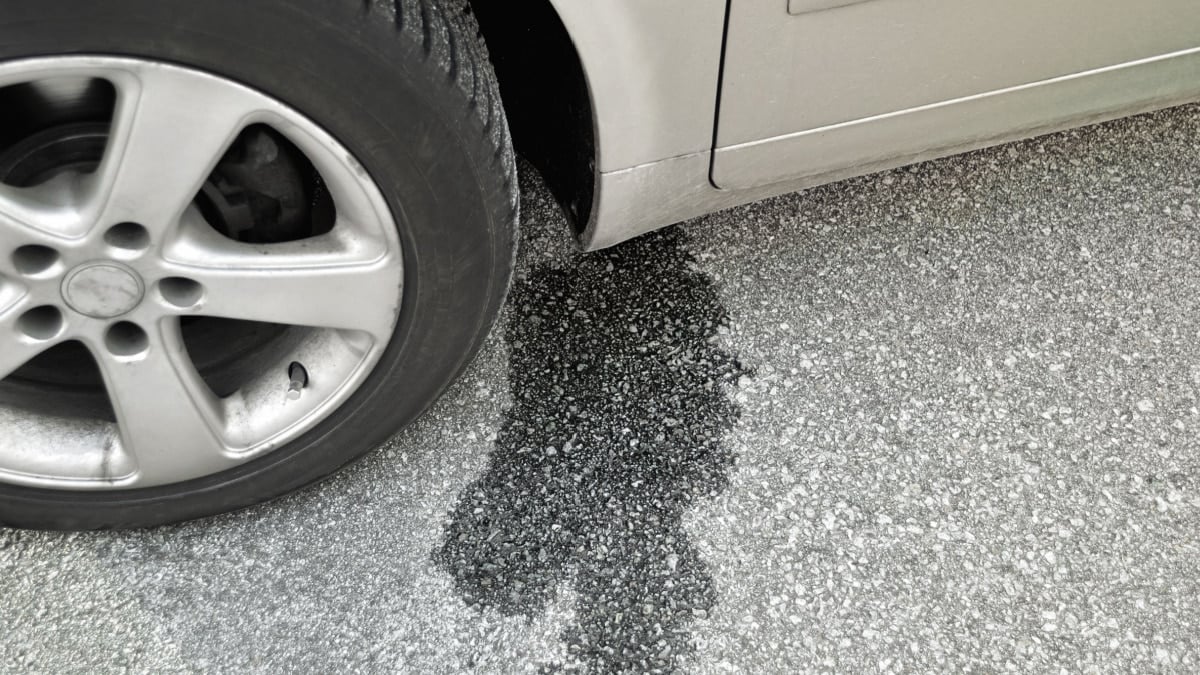If you see your car leaking fluid, it can be difficult to determine what’s going wrong. That’s why it’s important to know the color and odor of each fluid.
In this guide, we cover what to do when there’s fluid leaking from the car and how to identify the leak. We also answer your top questions, so you can repair the leak quickly.
What To Do If My Car Is Leaking?
If you spot liquid dripping from under the car, you are going to be initially alarmed, but there’s no reason to panic. Here are a few steps to keep in mind.
- Make sure the leaking fluid is actually coming from your vehicle. If you see a puddle beneath the car in a parking lot or on the street, it could have been from a car before you.
- Look under the vehicle to see where the leak is dripping from. If you see fluid on the underside of the vehicle, you may be able to better identify what it is.
- Determine what type of fluid is leaking. We will provide more guidance for this step in a minute. In the meantime, you may want to put a piece of cardboard under the leak, so you can get a better view of the color and odor of the fluid.
With that said, we do advise against using a stop leak additive unless it’s absolutely necessary. At best, these solutions provide a temporary fix, but even worse, they can cause serious damage to the engine and drivetrain.
Identify The Fluid
A fluid that is clear without a smell may just be dripping AC condensation. Light brown to black fluid is usually engine oil, while red or brown is transmission or differential fluid. Power steering fluid, brake fluid and coolant can be varying colors, while windshield washer fluid is normally blue or clear.
Let’s look at these fluids in-depth to determine what the leaking fluid might be.
1. Light Brown To Black: Engine Oil

Engine oil varies in color from light amber to dark brown or nearly black, depending on how old it is and how well the motor is running. The tricky thing about an oil leak is that it may not be directly under the engine.
These leaks can occur in obvious places, such as from the drain pan plug or oil filter. However, they can also occur in obscure places, such as from a crankshaft seal or the valve cover gasket. For this reason, you may need a professional mechanic to look at the system closer and find out where the leak is coming from.
If the leak is minimal, you may be able to continue driving for a short time. However, you don’t want the oil level to drop below normal or it could create serious engine damage. The best bet is to have the leak fixed immediately, so you can provide the best care for the engine.
2. Red Or Brown: Transmission Or Differential Fluid
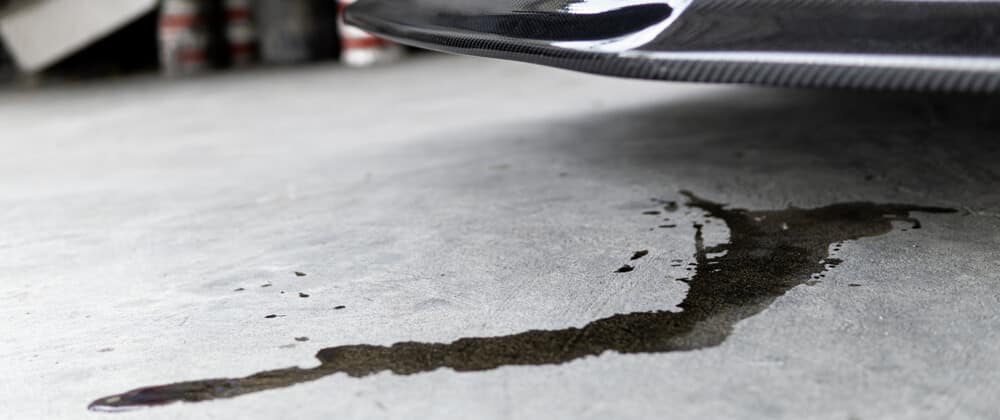
Automatic transmission fluid is often pink or red. Sometimes, you’ll notice other signs before the leaking fluid, such as a slipping transmission. When the transmission slips, the car will rev up without actually getting into gear. If you let the leak get too bad and the fluid becomes too low, the car will stop moving at all. Manual transmissions use gear oil instead. It’s similar to stronger-smelling engine oil and it’s thick.
With a front-wheel drive car, leaking fluid often drips from the axle seals. On the other hand, the rear-wheel drive car is susceptible to leaks from the output shaft seal.
Not all cars make it easy to check the transmission fluid. If there’s a leak and you can’t physically check the fluid level, you need to take your vehicle to a qualified transmission shop immediately. You don’t want the system to become too low.
Additionally, differential fluid can also leak. This fluid is thick and appears to have the consistency of honey. It also smells greasy and warm. If you get some on your hands, it is very difficult to get off and they may smell for days. Gear oil can be found on the rear axle seals and wheel bearing seals. You may also see it spread all over the rim because it splashed around.
RELATED: 6 Causes of Transmission Fluid Leaks
3. Thick Clear, Red, Green, Or Brown: Power Steering Fluid
It’s not always easy to determine the color of the power steering fluid. Some manufacturers use transmission fluid, while others have their own brand, such as Honda, whose fluid is light amber-colored. Some power steering fluids also smell similar to burnt cooking oil.
If you believe there’s a power steering fluid leak, take a peek at the reservoir to ensure there’s still enough in the system. Keep that topped off, or you may start dealing with a whining sound from the power steering pump. It can also become difficult to steer without the right amount of fluid.
Sometimes the power steering fluid leaks from either end of the rack. There could also be a bad line that needs to be replaced.
4. Transparent, Yellow, Or Brown: Brake Fluid

Brake fluid can be yellow, brown or transparent. It feels slightly oily but doesn’t tend to have much of a smell. If this fluid is leaking, you may start to experience trouble with the brakes. For that reason alone, it’s important to make sure that the reservoir is filled at all times.
This isn’t a leak you want to mess around with. If the fluid drains out, you could lose braking power and cause an accident.
RELATED: 5 Symptoms of a Brake Fluid Leak
5. Green, Yellow, Red, Or Blue: Coolant

Engine coolant is needed to regulate the temperature of the motor and provide lubrication. Every car used to have green coolant, but now it depends on what type is being used. For example, Honda has a blue coolant, while Toyota uses a red. There are also orange, clear and maybe other colors of the rainbow. Therefore, the color alone isn’t going to indicate anything.
What will help to differentiate a coolant leak is the smell. It’s sweet and candy-like, which is what makes it so dangerous to children and pets. Because coolant contains ethylene glycol, it’s extremely poisonous.
Coolant leaks can be found anywhere, especially in one of the hoses that tend to become brittle over time. The radiator is also a common location for a coolant leak.
Once you know there’s a coolant leak, you have a responsibility to keep a close eye on the reservoir. If the level gets low, the engine can overheat and you could deal with permanent damage. Even if the leak is minimal, it could change at any time, leaving you stranded on the side of the road. For that reason, we always recommend getting a coolant leak fixed immediately, no matter how small it is.
RELATED: How to Fix a Coolant Leak
6. Clear Without Smell: Dripping AC Condensation

When you see clear, odorless water dripping from under the car, there’s usually nothing to be alarmed about. This leaking water is probably just condensation from the air conditioning system. This water leak is common during the summer months and it should be more surprising to you if you don’t see water, as that could indicate a blockage to the drains.
If you see water coming from the exhaust in the winter times, this is also not a big concern. This is another condensation issue.
7. Clear With Strong Smell: Fuel Leak

Fuel is needed to keep the engine running. Yet, if a part of the fuel system fails, you could start to smell the gas while driving your car. Thankfully, leaking fuel has a distinct smell, so you should be able to tell what’s wrong very quickly.
Aside from the smell, you may not know what it is simply by looking at it. Gasoline is a clear liquid, so it’s important to trust your nose on this one.
Obviously, you don’t want to continue driving with any fuel leak. Not only can the smell make you sick, but you are also facing a higher chance of a car fire.
8. Blue Or Clear: Windshield Washer Fluid
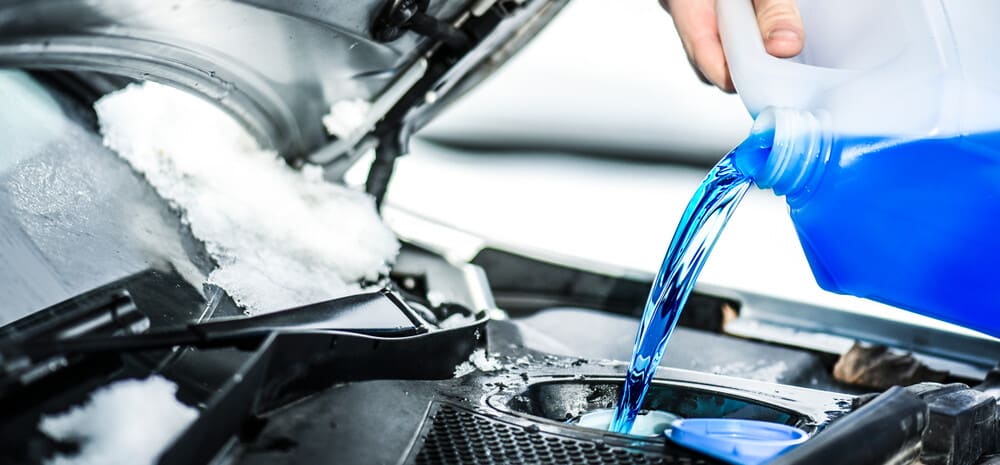
Other than some rarer coolant types, you won’t find anything blue except windshield washer fluid. This thin, watery-type substance is used to keep bugs and grime from the auto glass. Most often, leaks occur because of a cracked washer fluid reservoir.
While this isn’t an emergency situation, you still want to have it repaired as soon as you can. Without the ability to clean the windshield, you could end up with obstructions that block your view while driving, especially if a bird decides to leave a dropping on the glass while you are on the road.
Can I drive my car if it is leaking?
It depends on what the leaking fluid is. If you are noticing water from the air conditioner or some windshield washer fluid, you aren’t facing any serious issues. However, if one of the vital fluids is leaking, such as motor oil, transmission fluid, brake fluid, coolant or power steering fluid, you should get it fixed immediately.
What kind of leak under the car is okay?
You don’t want to see any leaking fluids under the car except water. This water is likely coming from the air conditioning system and is perfectly normal. It’s also not dangerous to see some windshield washer fluid leaking. While this isn’t an emergency situation, you still want to have the cracked reservoir fixed as soon as you can.
Should I be worried if my car is leaking?
Yes, it should cause you to jump into action. If the car is leaking any vital fluid, such as motor oil, transmission fluid, brake fluid, coolant or power steering fluid, your vehicle needs immediate attention. Without these fluids, the car won’t run as it should and you could allow permanent damage to expensive systems.
Does a car AC leak water?
Yes, if you’ve been running the air conditioning, you will probably see some water dripping under the front of the car. This is condensation from the AC system, most often from the evaporator core. If you don’t see water dripping, that would be more concerning.
Where would transmission fluid leak from?
There are several areas where the transmission can leak. It’s common to have a transmission pan leak or notice fluid coming from one of the seals. It can also leak from the front pump or a cracked line. Either way, you need to hunt down the source and fix it before it leads to shifting issues.
With a car leaking fluid, you have a very important job to do. You must figure out what is leaking and determine the source of the problem. With a simple piece of cardboard placed under the leak, you will be one step closer to solving the issue.
Unless your car is dripping water or leaking windshield washer fluid, you should take immediate action. All of the other fluids are necessary to the proper operation of your vehicle and a leak should never be taken lightly. If you can’t fix the problem yourself, get to a mechanic right away.
Categories: Brakes, Coolant, Engine, Engine Oil, Transmission, Troubleshooting

